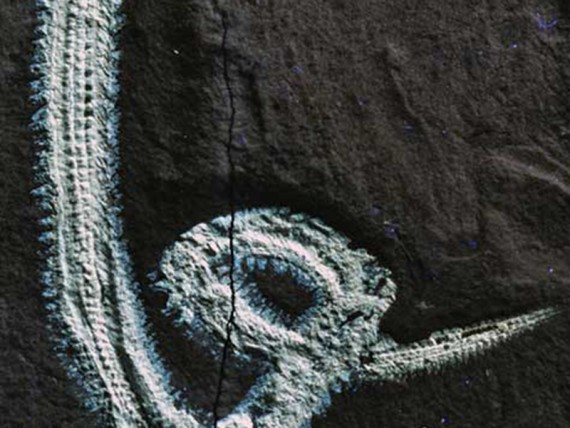Home News Article Biologists Discover Fossil Of Ancient Muscular Fireworm In Lebanon
Biologists Discover Fossil Of Ancient Muscular Fireworm In Lebanon
Kath C. Eustaquio-Derla August 24, 2017 0
23 November 2015, 7:06 am EST
By Katherine Derla Tech Times
British biologists discovered a unique fireworm fossil in Lebanon. The fossil turned out to be a novel species and is now called Rollinschaeta myoplena, after American punk rock star Henry Rollins. ( Luke Parry/University of Bristol )
A team of biologists in England unearthed a rare and novel fireworm fossil in Lebanon. They named it Rollinschaeta myoplena after American punk rock star Henry Rollins, Black Flag's muscular front man. The rare fossilized fireworm revealed an excellent muscle preservation and therefore explained the link to its new name.
The research team comprised scientists from the Natural History Museum and the University of Bristol. They analyzed the fossilized worm's muscle structure using CT scans. Based on its musculature, the Rollinschaeta myoplena belongs to the marine polychaetes family called Amphinomidae. When it comes to looks, the rare fireworm has many similarities to its modern-day cousins, who are predators found in coral reefs.
Well-Formed Musculature
he fireworms' muscles are given a daily workout when they forage for food amid the currents. Compared to their less buff worm cousins, the fireworms' well-formed muscles play a part in their preservation.
The analysis of the fossilized fireworms revealed major muscle groups such as circular muscles, parapodial muscle complex, longitudinal muscle bands, oblique muscles and gut muscles. The newly discovered extinct species had two pairs of dorsal, ventral, circular and longitudinal muscles. The research team was able to identify individual muscle fibers preserved in good resolution.
"Part of the reason why it's preserved so well by muscle is that it was, in real life, a very buff little worm. Fireworms are active during the daytime on coral reefs and other environments with strong currents which makes them much more muscular compared to most other bristle worms," explained co-author Jakob Vinther from Bristol's School of Earth Sciences.
Vinther added that the team initially called the find 'the muscle worm' because of its preservation "in almost pure muscle" and therefore decided to name it after a muscular punk rock star.
Muscle Tissue Preservation And Fossil Identification
A big predisposition in soft tissue fossilization was highlighted in the study. There are many other bristle worm species found in the area where the Rollinschaeta myoplena was discovered. However, these worm species are incapable of muscle preservation; if it happens, very little muscle is ever preserved. The team concluded that not all creatures are capable of excellent muscle preservation.
This premise is supported by Natural History Museum's Greg Edgecombe, who co-wrote the study. Edgecombe also said that the study pioneered fossil identification based on its musculature alone. Edgecombe added that exceptional preservation of the muscles can help the scientific community obtain more information about extinct species.
The rare finding of the muscular fireworm fossil was published in the BMC Evolutionary Biology journal on Nov. 17.
By Katherine Derla Tech Times
British biologists discovered a unique fireworm fossil in Lebanon. The fossil turned out to be a novel species and is now called Rollinschaeta myoplena, after American punk rock star Henry Rollins. ( Luke Parry/University of Bristol )
A team of biologists in England unearthed a rare and novel fireworm fossil in Lebanon. They named it Rollinschaeta myoplena after American punk rock star Henry Rollins, Black Flag's muscular front man. The rare fossilized fireworm revealed an excellent muscle preservation and therefore explained the link to its new name.
The research team comprised scientists from the Natural History Museum and the University of Bristol. They analyzed the fossilized worm's muscle structure using CT scans. Based on its musculature, the Rollinschaeta myoplena belongs to the marine polychaetes family called Amphinomidae. When it comes to looks, the rare fireworm has many similarities to its modern-day cousins, who are predators found in coral reefs.
Well-Formed Musculature
he fireworms' muscles are given a daily workout when they forage for food amid the currents. Compared to their less buff worm cousins, the fireworms' well-formed muscles play a part in their preservation.
The analysis of the fossilized fireworms revealed major muscle groups such as circular muscles, parapodial muscle complex, longitudinal muscle bands, oblique muscles and gut muscles. The newly discovered extinct species had two pairs of dorsal, ventral, circular and longitudinal muscles. The research team was able to identify individual muscle fibers preserved in good resolution.
"Part of the reason why it's preserved so well by muscle is that it was, in real life, a very buff little worm. Fireworms are active during the daytime on coral reefs and other environments with strong currents which makes them much more muscular compared to most other bristle worms," explained co-author Jakob Vinther from Bristol's School of Earth Sciences.
Vinther added that the team initially called the find 'the muscle worm' because of its preservation "in almost pure muscle" and therefore decided to name it after a muscular punk rock star.
Muscle Tissue Preservation And Fossil Identification
A big predisposition in soft tissue fossilization was highlighted in the study. There are many other bristle worm species found in the area where the Rollinschaeta myoplena was discovered. However, these worm species are incapable of muscle preservation; if it happens, very little muscle is ever preserved. The team concluded that not all creatures are capable of excellent muscle preservation.
This premise is supported by Natural History Museum's Greg Edgecombe, who co-wrote the study. Edgecombe also said that the study pioneered fossil identification based on its musculature alone. Edgecombe added that exceptional preservation of the muscles can help the scientific community obtain more information about extinct species.
The rare finding of the muscular fireworm fossil was published in the BMC Evolutionary Biology journal on Nov. 17.









